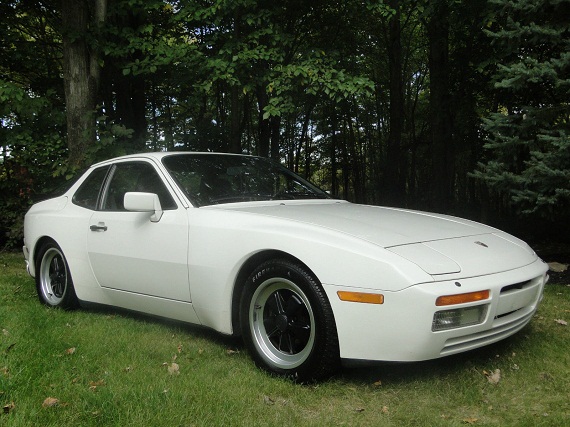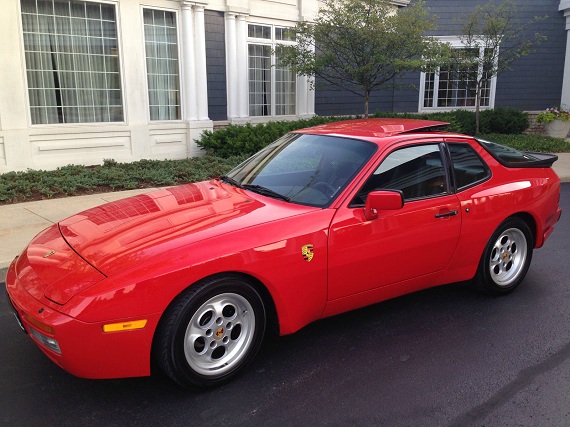One of the things I love most about these 10K posts is the breadth of selections and ideas that I dream up to try to pull together. Today’s thought was about practical performance – what’s the most your can buy for $10,000? As a result, we have quite a diverse selection to make it through today, ranging from a 2.0 TDi gas sipper through a 5.5 liter, twin-turbocharged V12 torque monster. In their respective ways, each is a great car (at least, in premise) and probably defines its category. What’s your favorite of this group?
Tag: 951
Without a doubt, for many years my favorite sleeper deal in the realm of factory Porsche race cars was the 944 Turbo Cup. Constructed for one-make support races around the world, the Turbo Cup model has some really neat features – notably, the inclusion of a healthy amount of magnesium to help lighten the car, plus a bit more boost to motivate it. For some time, 944 Turbo Cups were just downright cheap for a full factory racer, but recently they’ve spiked up in value and are now pretty much out of the reach of most mortals. Of course, if you’re willing to forgo the factory Cup build status and a few of the more pricey magnesium details like the original wheels, you can still find great track or race bargains in the 944 Turbo:
CLICK FOR DETAILS: 1989 Porsche 944 Turbo Race Car on eBay
Comments closedFor some time, there has been an ongoing conflict in my head. All of me agrees that the Porsche 944 is a pretty awesome car; great looks, handling and performance in a bargain package with classic Porsche reliability and build quality. But I fight with myself over just which of the Porsche 944s I prefer. Some days, the forced induction Turbo captures my imagination; there’s been a 1989 Turbo in my family now for two decades and it’s a wonderful car. But I have to admit that it’s not been without its problems, and while it’s a cool package it seems almost too predictable as the “go to” “cheap” Porsche. Should it be criticized for being a spectacular performance bargain? That may not be fair, but just like the BMW E30 represents a good balance of performance and practicality, it’s sometimes just too popular for me. What’s the alternative? Well, the 944 has its own answer: the 944S2. Visually, the two are nearly indistinguishable to most non-enthusiasts. But the driving experience is quite different; the M44/51 turbo motor is legendary as a tuning platform and offers typical ’80s lag-prone explosive launches, while the M44/41 big 3.0 16V motor has seemingly effortless torque at your disposal but loves to run up the tach as well. Stand on it in a drag race, and the Turbo will win – nearly a second faster to 60 miles per an hour and 5 m.p.h. faster on the top end. But if you’re a clever S2 driver and catch the Turbo slightly off-guard, you’ll be right with them – and the S2 isn’t about drag racing, it’s about making a better all-around driver. So the S2 is the better choice? Well, perhaps – but then there’s the mystique of the Turbo model. Who doesn’t want to say they own a Porsche Turbo, really? Today I have an example of each – which will be the winner?
CLICK FOR DETAILS: 1987 Porsche 944 Turbo on eBay
4 CommentsIt’s pretty amazing to me that the Porsche 944 Turbo hasn’t taken off in value. Compared to its contemporaries, the Quattro, 190E Cosworth and M3, the 944 Turbo still has yet to fully appreciate. Perhaps it’s that there are many good examples – true, a fair amount of 944s have hit the track where they shine, but there are still mint condition examples that pop up and remind us what a well-rounded car the 951 is. Supercar performance was possible from the turbocharged inline-4 2.5 liter engine; it had better brakes, better balance and amazingly even better fuel mileage than the other three. Perhaps the only downside was that it’s much better suited for 2 to transport than the 4 that can fit in the more sedan-like competition, but outside of that the 944 Turbo is really a superior package. Nearly 14,000 of these cars were imported to the U.S. alone; that’s a higher production total than the entire Quattro production line world-wide, for example, and about three times the amount of M3s and seven times the number of 190E Cosworths that were imported. For enthusiasts, that means they’re still quite affordable and, being Porsches, many good examples can be found. The cheapest of the bunch are the early cars, which offered a bit less power and not quite as heavy duty suspension and brakes that were found on the “S” and 1989 models. Today’s examples are both 2-owner cars with lower miles and in great shape – which would you choose?
CLICK FOR DETAILS: 1986 Porsche 944 Turbo on eBay
1 CommentMy first experience with a 944 Turbo was very memorable; I was a passenger in a ’89 Turbo at Lime Rock Park with a very experienced instructor. Though I knew he was a good driver, my 13 year old mind couldn’t cope with the way the car gained speed; I was transfixed in fear and exhilaration as the g-forces pulled my legs off the floor over the uphill. When I finally got the chance to drive one a few years later, I figured this performance was instantaneous; seeing a gap in traffic that was just large enough for a French Poodle, I popped the clutch and floored it – grasping the wheel with all my strength for the impending carrier launch that was about to occur. But as my mind played Kenny Loggin’s Danger Zone, a realization slowly crept over me – I was barely moving. I looked in the mirror, fully anticipating the crunch of impact as I was rightly rear-ended by the driver I had just cut off. But as the grill loomed large and I winced in pain, the engine came on boost – suddenly, there was no road ahead of me, only sky. The car launched forward with an enthusiasm I can still feel. I was used to quick acceleration, growing up with a E28 M5 in the family – but this car was different. The all-or-nothing throttle pedal made you feel as if only you knew how to drive the car; it was like a secret that hid supercar performance. Push a little and you’ve got an economy car getting 30 m.p.g on the highway – push a lot and you’re gaining speed in 30 m.p.h. increments:




